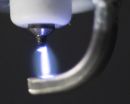INFORMATION:
Other members of the research team include several from the Temple Department of Microbiology and Immunology including first authors Paul M. Gallo and Glenn J. Rapsinski, as well as R. Paul Wilson, Gertrude O. Oppong, Uma Sriram, and Bettina Buttaro. Other authors include Roberto Caricchio, Division of Rheumatology in the Department of Medicine at TUSM, and Mark Goulian from University of Pennsylvania Department of Biology.
The research was supported by the National Institutes of Health, the National Institutes of Allergy and Infectious Diseases (1R03AI107434, 1R21AI105370, RO1-AI076423), the Fox Chase Cancer Center-Temple University Nodal grant, the Lupus Research Institute Innovation Research Grant, the Lupus Foundation's Goldie Simon Preceptorship Award and the National Institute of Arthritis and Musculoskeletal Skin Diseases (RO1-AR061569)
About Temple Health
Temple University Health System (TUHS) is a $1.8 billion academic health system dedicated to providing access to quality patient care and supporting excellence in medical education and research. The Health System consists of Temple University Hospital (TUH), ranked among the "Best Hospitals" in the region by U.S. News & World Report; TUH-Episcopal Campus; TUH-Northeastern Campus; Fox Chase Cancer Center, an NCI-designated comprehensive cancer center; Jeanes Hospital, a community-based hospital offering medical, surgical and emergency services; Temple Transport Team, a ground and air-ambulance company; and Temple Physicians, Inc., a network of community-based specialty and primary-care physician practices. TUHS is affiliated with Temple University School of Medicine.
Temple University School of Medicine (TUSM), established in 1901, is one of the nation's leading medical schools. Each year, the School of Medicine educates approximately 840 medical students and 140 graduate students. Based on its level of funding from the National Institutes of Health, Temple University School of Medicine is the second-highest ranked medical school in Philadelphia and the third-highest in the Commonwealth of Pennsylvania. According to U.S. News & World Report, TUSM is among the top 10 most applied-to medical schools in the nation.
Temple Health refers to the health, education and research activities carried out by the affiliates of Temple University Health System (TUHS) and by Temple University School of Medicine. TUHS neither provides nor controls the provision of health care. All health care is provided by its member organizations or independent health care providers affiliated with TUHS member organizations. Each TUHS member organization is owned and operated pursuant to its governing documents.
Temple-led research team finds bacterial biofilms may play a role in lupus
2015-07-06
(Press-News.org) (Philadelphia, PA) - Lupus, multiple sclerosis, and type-1 diabetes are among more than a score of diseases in which the immune system attacks the body it was designed to defend. But just why the immune system begins its misdirected assault has remained a mystery.
Now, researchers at Temple University School of Medicine (TUSM) have shown that bacterial communities known as biofilm play a role in the development of the autoimmune disease systemic lupus erythematosus -- a discovery that may provide important clues about several autoimmune ailments.
A team led by TUSM researchers Çagla Tükel, PhD, and Stefania Gallucci, MD, show how bacterial biofilms found in the gut can provoke the onset of lupus in lupus-prone mice. The research is published in the current issue of the journal Immunity. Dr. Tükel is an Assistant Professor of Microbiology and Immunology at TUSM, and Dr. Gallucci is Associate Chair, Microbiology and Immunology, as well as an Associate Professor in Microbiology and Immunology at TUSM. Both are members of the Temple Autoimmunity Center.
"This work stresses the importance of considering infections as a possible trigger for lupus," Dr. Gallucci said. "Very little was known about how biofilms interact with the immune system because most of the research has been looking at how biofilms protect bacteria, how they make bacteria resistant to antimicrobials such as antibiotics, but almost nothing was known about what biofilms do to the immune response," she said.
Biofilm is a densely packed bacterial community that excretes proteins and other substances. Those substances form a matrix that protects the bacteria from antimicrobials, the immune system, and other stressors. Biofilms can occur in our guts, among the bacteria that help us digest. They exist as dental plaque, or arise in urinary tract infections. They also can find a home on man-made surfaces such as intravenous catheters. Central to the lupus story is a biofilm protein deposit called an amyloid. In the common gut bacteria E. coli, as well as the bacteria often responsible for severe gastrointestinal distress that accompanies food poisoning, Salmonella Typhimurium, amyloids are called curli because of their curly fiber-like appearance.
Also part of the biofilm is DNA excreted by bacteria. The Temple team discovered that when curli amyloids and DNA meet, they form remarkably durable bonds in the biofilm. When the researchers attempted to separate the DNA from these bonds using a variety of enzymes as well as chemicals, the curli wouldn't let go. Curli-DNA complexes speed up the creation of the biofilm, the researchers learned. And the Temple researchers found it is also in this composite of curli-plus-DNA that autoimmune trouble appears to arise.
It's long been known that infection is associated with lupus flares -- a flare in lupus is when symptoms worsen. Indeed, infections play a role in between 20 percent and 55 percent of lupus patient mortality. Up to 23 percent of hospitalizations in lupus patients are due to infectious disease complications. Further, the bacteria Salmonella are more aggressive in lupus patients, with the ability to create potentially lethal complications.
The new research shows that the complexes formed from curli amyloid and DNA in the biofilms of both Salmonella and E. coli give rise to not only inflammation, but the self-attacking antibodies of lupus.
To demonstrate the role of biofilms in immune response, the researchers wanted to see how the sentinels of the immune system, called dendritic cells, reacted to a biofilm. The dendritic cells sent "tendrils" into the biofilm and ate up part of it to signal other molecules. Further, they produced large amounts of chemicals called proinflammatory cytokines. These cytokines are important in inciting the immune system to act. Among the cytokines was Type-1 interferon, known to be associated with lupus.
"I was super excited when I saw how activated the dendritic cells were on the biofilm " Dr. Gallucci said. The levels of cytokines released when dendritic cells were exposed to curli-DNA complexes actually exceeded the most robust response known previously -- the response to lipopolysaccharide (LPS).
To test if the immune response seen in the laboratory would be enough to induce autoimmunity and the attack on self that occurs in lupus, the researchers used mice that are prone to develop autoimmune disease. As is the case with many diseases, lupus is the result of a genetic propensity that lies dormant in the absence of an environmental trigger. The researchers wanted to see if the curli-DNA complexes could provide that trigger. They injected susceptible mice with the amyloid-DNA composites or a placebo. Within two weeks, the researchers found the kind of antibodies that attack "self," known as autoantibodies. The autoantibodies, which target double-stranded DNA, are a diagnostic hallmark of lupus. The response was remarkably fast. It normally takes mice four to five months to develop autoantibodies.
Another strain of mice that do not develop lupus spontaneously but are genetically predisposed to autoimmunity also reacted to the curli-DNA composites with rapid production of autoantibodies. A third strain of mice with no propensity for any autoimmune disease, developed autoantibodies within two weeks of injection, but at lower levels than in the mice with a propensity toward lupus.
All mice developed the autoantibodies whether the curli-DNA composites came from Salmonella or from the kind of E. coli that's found in a healthy digestive system. In fact, three of the four bacterial families that contain curli genes are found in the gut: Bacteroidetes, Proteobacteria, and Firmicutes, suggesting a possible source of vulnerability in susceptible patients. "How that happens, I think that will be the next level of our project," Dr. Gallucci said. The research team is already looking at mouse models to see what may lead to the escape of curli-DNA complexes from the gut. Further, the team is collaborating with rheumatologist Dr. Roberto Caricchio, Director of the Temple Lupus Clinic, to see if the patients show signs of exposure to the curli-DNA complexes.
"The next step is to explore the mechanism of how these composites are stimulating autoimmunity," Dr. Tükel said. "The beneficial bacteria found in our guts can cause problems when they cross the intestinal barrier and reach to places they shouldn't be. Thus, besides infectious bacteria, a leaky gut could cause many problems. We are now starting to understand how the bacteria in our gut may trigger complex human diseases including lupus. So it's critical for us to understand the biology of the bacterial communities and their interactions with the immune system."
The research may offer clues to diseases involving amyloids, Dr. Tükel said. For instance, amyloid plaques in the brain are a signature of Alzheimer's disease. Type-2 diabetes and Parkinson's disease also feature amyloids. "Right now, we can only speculate," she said. "Some reports suggested that antibiotic treatment may be changing the course of Alzheimer's disease. Antibiotics are thought, in some cases, to slow the mental decline suggesting that bacterial infections, or a bacterial component, may be contributing to the disease. That could be a link, but for the moment, it's only speculation."
Understanding how biofilms trigger autoimmunity may ultimately lead to changes in patient treatment, Dr. Gallucci said. "So understanding how the biofilms affect flares could lead to a different treatment approach. Now, they give immune suppressive drugs. Maybe you want to do something else, like treat the underlying infection."
ELSE PRESS RELEASES FROM THIS DATE:
Adolescents who view medical marijuana ads more likely to use the drug, study finds
2015-07-06
Adolescents who saw advertising for medical marijuana were more likely to either report using marijuana or say they planned to use the substance in the future, according to a new RAND Corporation study.
Studying more than 8,000 Southern California middle school students, researchers found that youth who reported seeing any ads for medical marijuana were twice as likely as peers who reported never seeing an ad to have used marijuana or report higher intentions to use the drug in the future. The study was published online by the journal Psychology of Addictive Behaviors.
Researchers ...
Perennial biofuel crops' water consumption similar to corn
2015-07-06
Converting large tracts of the Midwest's marginal farming land to perennial biofuel crops carries with it some key unknowns, including how it could affect the balance of water between rainfall, evaporation and movement of soil water to groundwater.
In humid climates such as the U.S. Midwest, evaporation returns more than half of the annual precipitation to the atmosphere, with the remainder available to recharge groundwater and maintain stream flow and lake levels.
A recent study from the Great Lakes Bioenergy Research Center and published in Environmental Research ...
Study provides new insights into the genetics of drug-resistant fungal infections
2015-07-06
Worcester, Mass. - A study by a multidisciplinary research team, co-directed by Worcester Polytechnic Institute (WPI), offers new insights into how virulent fungi adapt through genetic modifications to fight back against the effects of medication designed to block their spread, and how that battle leaves them temporarily weakened. These insights may provide clues to new ways to treat notoriously difficult-to-cure fungal infections like thrush and vaginitis.
The team studied patients infected with the fungus Candida albicans (C. albicans), which causes common yeast infections ...
Protein implicated in osteosarcoma's spread acts as air traffic controller
2015-07-06
WASHINGTON (July 6, 2015) -- The investigation of a simple protein has uncovered its uniquely complicated role in the spread of the childhood cancer, osteosarcoma. It turns out the protein, called ezrin, acts like an air traffic controller, coordinating multiple functions within a cancer cell and allowing it to endure stress conditions encountered during metastasis.
It's been known that ezrin is a key regulator of osteosarcoma's spread to the lungs, but its mechanism was not known. Osteosarcoma is a tumor of bone that afflicts children, adolescents and young adults. In ...
Link found between autoimmune diseases, medications, and a dangerous heartbeat condition
2015-07-06
Mohamed Boutjdir, PhD, professor of medicine, cell biology, and physiology and pharmacology at SUNY Downstate Medical Center, has led a study with international collaborators identifying the mechanism by which patients with various autoimmune and connective tissue disorders may be at risk for life-threatening cardiac events if they take certain anti-histamine or anti-depressant medications. Dr. Boutjdir is also director of the Cardiac Research Program at VA New York Harbor Healthcare System.
The researchers published their findings in the online edition of the American ...
Stress-fighting proteins could be key to new treatments for asthma
2015-07-06
Investigators have discovered the precise molecular steps that enable immune cells implicated in certain forms of asthma and allergy to develop and survive in the body. The findings from Weill Cornell Medical College reveal a new pathway that scientists could use to develop more effective treatments and therapies for the chronic lung disorder.
More than 1 in 12 Americans are affected by asthma, a disorder characterized by an overactive immune response to normally harmless substances such as pollen or mold. Scientists had previously discovered that an overabundance of ...
Restraint and confinement still an everyday practice in mental health settings
2015-07-06
Providers of mental-health services still rely on intervention techniques such as physical restraint and confinement to control some psychiatric hospital patients, a practice which can cause harm to both patients and care facilities, according to a new study from the University of Waterloo.
The study, which appears in a special mental health issue of Healthcare Management Forum, found that almost one in four psychiatric patients in Ontario hospitals are restrained using control interventions, such as chairs that prevent rising, wrist restraints, seclusion rooms or acute ...
Older patients with spinal cord injury: Surgery less likely than for younger patients
2015-07-06
Older patients with traumatic spinal cord injury are less likely than younger patients to receive surgical treatment and experience a significant lag between injury and surgery, according to new research in CMAJ (Canadian Medical Association Journal)
The number of people with traumatic spinal cord injury over age 70 is increasing, and it is projected that people in this age group will eventually make up the majority of those with new spinal cord injuries. Currently, most spinal cord injuries occur in people aged 16 to 30 years.
To determine whether patients over age ...
Mass. General team generates therapeutic nitric oxide from air with an electric spark
2015-07-06
Treatment with inhaled nitric oxide (NO) has proven to be life saving in newborns, children and adults with several dangerous conditions, but the availability of the treatment has been limited by the size, weight and complexity of equipment needed to administer the gas and the therapy's high price. Now a research team led by the Massachusetts General Hospital (MGH) physician who pioneered the use of inhaled nitric oxide has developed a lightweight, portable system that produces NO from the air by means of an electrical spark. The investigators describe their invention in ...
Uncovering the mechanism of our oldest anesthetic
2015-07-06
CAMBRIDGE, MA -- Nitrous oxide, commonly known as "laughing gas," has been used in anesthesiology practice since the 1800s, but the way it works to create altered states is not well understood. In a study published this week in Clinical Neurophysiology, MIT researchers reveal some key brainwave changes among patients receiving the drug.
For a period of about three minutes after the administration of nitrous oxide at anesthetic doses, electroencephalogram (EEG) recordings show large-amplitude slow-delta waves, a powerful pattern of electrical firing that sweeps across ...


